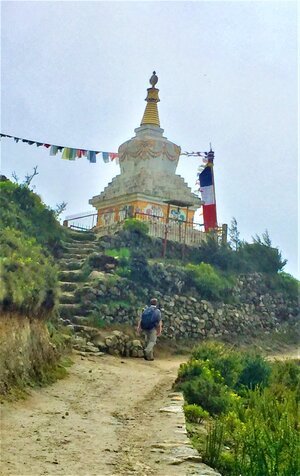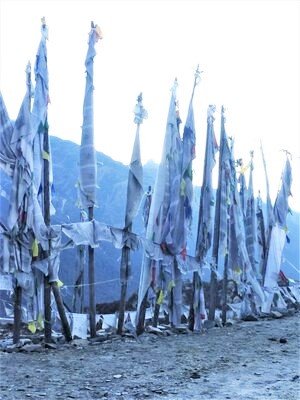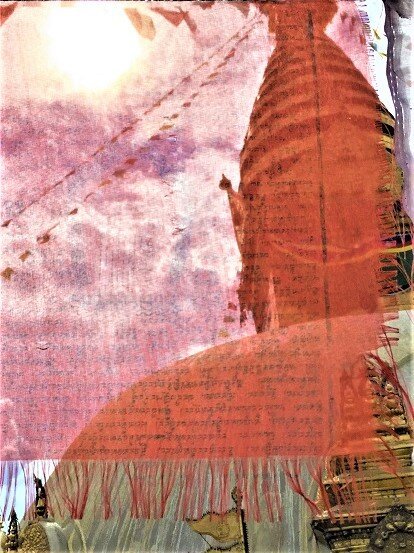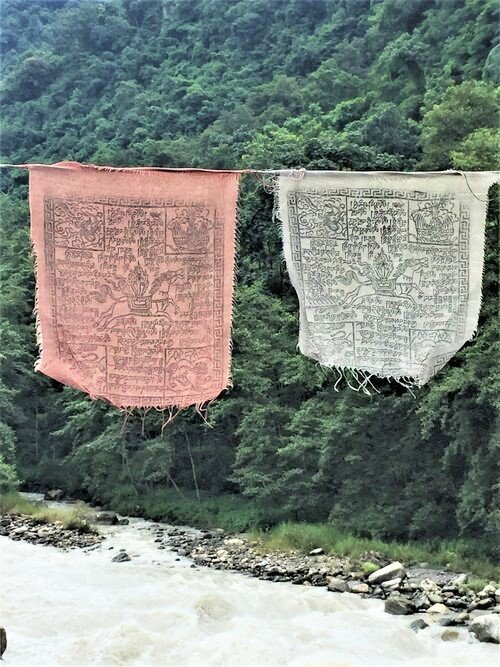vaga #6/1 puffff Nepal
PART I
What remained in my memory of Nepal, in addition to the mountains, are the prayer flags. The well-known and now marketed "Tibetan flags." The flags arrived from India to Tibet around 800 AD. I have a fibre that runs through me intimately and emotionally tied with the fibres of genres "the rags". I call all fabrics rags, be it sacred, or even my own work from my first art installation are "rags" and I don't want to insult anyone, it's just generic, and I mean it with respect. From there I have published the monks' robes in vaga # 1 obsessions 1, part IX, or the sheets in vaga # 1 Tour “b”, part XIII, and I have much more in the portfolio. In this chapter the Tibetan flags will accompany us, a break from so many photos of ruins and people, it is also the essence of Tibetan Nepal.
photos of the trek to Everest base camp, the flags cross the valleys it is sometimes impossible to know how they are hung, only three exemplify the many that one sees when walking
Yes, I wanted to know it. I have always wanted to go to Nepal, !!!!! for its mountains !!!!!, Nepal was a must, but without expectations. I had the maximum stay visa until the last day, which is 5 months, divided into three batches, (between June and December 2018) and obviously, I fell short. It is a country to which I would like to return to for a long time. For the record, I did 3 treks in different areas of the Himalayas, and it was the most impressive of my stay. The first one to Everest base camp with my eldest son, Rafael, was amazing, as it was the first experience in the Himalayas and the other was seeing me trekking which I did not think I could, I was not in the physical condition, nor did I train for a single day, and it was a wonderful gift to me, and unexpected to achieve it. I will soon dedicate the block "vaga # 7" to the Himalayas and my passage through the majestic mountains. I am going to refer "vaga # 6" to central and northern Nepal, the area of the Himalayas that covers much of the country and is the most interesting. There are many ethnic groups with their 123 recognized dialects. In the East of the largest mountain range in the world, the vast majority are Tibetans. The geographical limits and I am going to make a comment in the margin and I hope not to repeat myself, the borders of Central Asia, South and East, part of Africa were made by agreement between the European colonisers: French, Italians, English, Portuguese, Dutch, Spanish and many others Sometimes the Pope took part in the distribution of these, without having set foot on the earth, nor knowing its geography, nor the established cultures much older than the European ones. I would say that all ethnic groups and I mean the countries that I have travelled to, were divided into several countries, like the Masai between Kenya and Tanzania, to say something that at least I know, I think it was a mistake because what existed before for many centuries and their agreements and disagreements between them was not studied, nor respected. This has created to this day in Africa interethnic turf wars, gruesome genocides, refugee camps, entire displaced peoples, and it is all the fault of the settlers and their divisions made in an office in Europe. The same thing happened with the Tibetans who stayed between China and Nepal. They have very characteristic Mongolian faces, Buddhist, while the south of the country, have plains, with a tropical climate, and an abundance and variety of crops. It was formerly part of India and its Hindu traits and religion, religious and commercial ties are abundant to this day and are very close. Nepal was one of the few countries that were not colonised, like Thailand (both with an agreement to grant benefits to the settlers) the rest were not saved. Nepal, reached an agreement with the English in 1817, they were interested in an independent buffer between India (India / English) and the Chinese empire for fear that they would invade the south. Among the agreements not to colonise it was that they contributed troops to the English armies during the colony. This army turned out to be known worldwide as the Gurkha. Historically it was the army of the Gurkha dynasty that conquered lands in the mountains for the reign of Nepal. Known as fierce warriors they were initiated at 5 years of age, and they were a pride for families. England maintains a contract for mercenaries to this day; they participated as the Gurkha army in the First and Second World Wars and in the Falklands. It is the last mercenary army in the world. They currently live with their families in England and are in the process of obtaining all the benefits as any Englishmen. They also provide services to the armies of India, part of it not receiving the same salaries as those of the English military they joined from India, at moment of the Indian Independence Brunei has also hired them and Singapore hired them in 2018, for Trump's safety. In 1951, the first parliament was installed, interrupted between 1960 and 2005 with a civil war between communist guerrillas who came to control 80% of the country, against the Nepalese monarchy. Only in 2008 did democracy return, but it was always unstable, corrupt and the monarchy was abolished. Currently, a woman is a president, and it is run as a Communist country with independent rules.
A Nepalese friend summed up Nepal for me in three words: Buddhism, Hinduism, Tourism. I found it great because it is like that, religions are lived intensely, life is marked between the festivities those that are sacred, whether Hindu (80%) or Buddhist, both festivities are respected as national days and the truth is that they are very mixed between them, sharing some festivities. Tourism in the Himalayas is strong, in Kathmandu alone there are more than 3 thousand tourism agencies and one million tourists entered last year (2019)
The geography of the Himalayas covering something like 85% of the country is essential to understanding its culture, poverty and backwardness on a global level. I put a map to size and visualise what geography imposes. I come from the Cordillera de Los Andes, which is a narrow and linear range of mountains. So narrow and for example, in the Portillo area of central Chile towards Argentina, it crosses a splendid highway in an hour. More time is spent in border formalities than crossing it, while the Himalayas are made up of endless chains after chains, hills after hills, valleys after valleys on all sides and all steep, dramatic. Leaving Kathmandu by bus to the south you go down about 3 hours of mountains that are already softer by then and that is on the edges of the Himalayas.
It is a very poor country and its complex geography makes everything impossible to advance with infrastructure, schools, primary health posts, communications. They are a great challenge, everything that has been achieved has been only through international aid. Literacy in 1951 was only 5% with 300 schools, since 2011 they are working at full speed to overcome this, today they have managed to reach 35 thousand basic schools. In addition to the effort to implement them, it is forcing parents to send their children since they work together with their parents and need them as labour in the tasks of family support, it has been like this forever (the concept of childhood is from modern times ) and makes them understand that education brings progress and an improvement in life. This has slowly changed, first they sent one child per family, or women because men help more in hard tasks. Currently, attendance at the basic level is high in the country, more than 90%. Until recently there were only slightly more than 10,000 paved kilometres and 16,000 of dirt, and both are unusable or partially so in the rainy season. In 2018 the country was only connected by road except for one region. Nepal depends almost entirely on foreign assistance in all countries such as China, India and Japan in extensions and maintenance of roads. The European Union and the United States, in health, education ... The vast majority of the country does not have access to a road, so you simply walk for days and weeks (a topic that I will expand on in another chapter) The nearest port remains in India. In communications by geography, there is a shortage of signage in much of the country, another obstacle to progress. The massive use of the internet is only through the telephone and not by computer.
flags cross valleys, rivers, are in memorials, stupas, monasteries, streets, houses.
With respect to the population, more than 28 million, 20% live in the city and the great remaining percentage lives on their self-subsistent land and animals. More than 2 million young people work outside the country, Malaysia, the Persian Gulf, among others and are sometimes exploited, with low wages and in unacceptable conditions today. The Nepali have the caste system, as social stratification, but it has been losing importance, and fewer marriages are arranged until marriages with different castes are accepted. The flag is the only one that is made up of two triangles and not rectangular like the rest of the world. The calendar system is called Bikram, (ancient from Hindu) and is fifteen days out of date with the world (Gregorian Calendar), today is the year 2072, as well, which does not coincide with the Buddhist year like the one in Thailand 2563. The New Year is in the middle of April, Sundays are workdays, and Saturdays are off. What I have described is intended to support my appreciation, personal and comparative conclusions of what I know from other cultures. What marked me the most was its people. The Nepalese are world-renowned for their smiles, and it is a personality trait. The cordiality between them is astonishing an example: when I got into a taxi with Gopal, my friend and trekking guide, they do not stop talking. I ask them what they are talking about because in every taxi and restaurant it was the same thing. They talk about where they come from, what ethnic group they are, how long they have been in the city and continue, for a long time. Now in the "Tea House", places where you sleep in the mountains and are owned by the locals when we arrived there were already so many as well as places to eat, they sit and talk non-stop. The “walkers” (those who go from one place to another with loads of food, construction materials, gas balloons,… on their backs Sherpas, it is an ethnic group, and they are only from a part of the Himalayas but known to be carriers) or those who visit their parents, in short, it is the life of the Himalayas. They exchange news, send errands, find out about the weather, a crucial thing, many parts of the country have no radios and less than no signal of Wi-Fi they are the ones who act as communicators and because of the extreme isolation, share a meal, and talk with a "raksi" in the hand (rice liqueur) is always welcome. So the habit of talking to each other, helping each other passing information of all kinds, sharing the adversities and non-adversities of the day of walking. It is the same attitude with the tourists, even if they don’t speak English. The smile is always present.
There are vertical ones called "Darchor" which means, life, fortune, health, prosperity, compassion for all sentient beings (some photos are taken at dawn for the reason that it's light)
I had so many experiences with Nepalese in this aspect, the taxi driver from the hostel in Kathmandu took me to see his house, a room, where his mother was about 90, she was surely 67 years old, impressive on the one hand the poverty. They (husband and wife) slept in a large bed and the mother on the floor. She was paralysed and sat all day on a foam mattress. A face full of wrinkles could not fit one more, without any teeth, and she would take my hands and smile at me. Everything was precarious, a fire on the floor, and a couple of pots, buckets of water and there was nothing more. Now, why is the taxi driver taking me? that is the spirit, never ever seeking charity, never ever showing his poverty for compassion, he felt it with pride, joy, explaining everything to me, zero communication with his wife and mother, but attentive to serving tea to a stranger who dropped in I would have taken pictures of that old woman, but it was absolutely out of place, it only remained in my retina like the rotten smell of the room without a window ... Why invite me? There was never a request for money or a hint, but they thank you for meeting them, that you looked at them, that you listened to them, that you smiled at them. That happened to me often, and many invitations that I did not go to, I didn’t have the skin. Several times they made me talk by video on WhatsApp with their family, husband, brother and there one talking to strangers, but they want to introduce you. Pokhara, a beautiful town in the west, I always went to the same restaurant and the manager talked to me and told stories about his country, his family, what he did on his days off ... .., the last day he gave me one of the typical sacred scarves, for nothing, never as a recognition to a good client and to leave her happy, but for the time-shared and for being interested in their stories. The dentist invited me to her house, but in the end, I did not go. Thamel, is the historical centre of Kathmandu and I lived there, I went out every day, soon they greeted me to the right and left, and sometimes I avoided going through certain streets because I had to have tea, or insisting on eating in their houses. So I met some art students on the street and a friendship developed, I went to Art school often, and I became great friends with one of the masters until today.
Photos of the bridges and the ones I post are from the Everest trek. All the bridges, are a blessing to have, and they are rather recent about a decade, or a little more, and they save you days of walking. Furthermore, the hard work of carrying a load on the shoulders to supply its inhabitants with the minimum must be added all the risks that inclement weather implies, the valleys are steep as seen in the photo and they are one after the other and without respite, then crossing "those" rivers and in the rainy season it is impossible, therefore everything is much more isolated, and it must be considered that in the winter the supply is also suspended. For them, they pack mules (photo) and yaks also pass through them. All have been donated by foreign institutions and the recognition plaque is found on each one, either to Japan, China, European Union, some NGOs, among others. You have to bless them, and they show appreciation with their sacred flags, making life a little easier than the hard life they lead. Blessing them also that they do not fall because it is certain death and replacing it may take years. Therefore, all the bridges have flags, some have a single line to the side, taking advantage of the cable or in height, and letting the wind from the valley make them flap. Some are overloaded with flags and coincide with the most appreciated bridges, those of great height, those of high risk. I understand the titanic engineering behind the bridges, but the flags that are installed by themselves are sometimes an enigma like the ones that hang across one of those valleys.
It is magical to cross those bridges with their flags in the knowledge that they are prayers and by good fortune, it is a very peculiar and beautiful spectacle
And as I said, me and the fibre that I have with the fibres of the rags, which is why these scenarios make me hallucinate, I could not cross the bridge without having spent a good time looking at it from a distance, seeing how those hundreds of flags were flying, how I felt that prayers flew through the valley tirelessly.
There is a great silence in the valleys, especially when you are at that height, and you cannot hear the river, except on the bridges you can hear the subtle murmur of the flapping, playing with its colours without ceasing, without getting tired, tolerating all kinds of storms and snowfalls.
I prefer the fading and tattered flags, those that have flapped for months, years, those that have endured the cold, the rain, the storms, the sun and do not give up until the last thread is completely unravelled.
a sacred scarf that flew through the winds to get hooked on a tree. Walking past and seeing it in the distance moved me and I wonder when it will leave again with the next big wind to other forests carrying the sacred spirit that the Nepalese gave it
Kathmandu, in Thamel, is a central and historical neighbourhood with its bazaar-like streets, a maze of dirt roads and some paved roads. They are put more for decoration, it is the tourist area, but it is still beautiful and gives the place its Nepalese identity.
They are found in all temples, pagodas, stupas.
MY HOMAGE TO TIBETAN HOLY FLAGS
I had a lot of fun taking pictures of flags in a pagoda playing with the sun and its transparencies, because I can't take my eyes off the “rags”.
In the Kathmandu valley with Peter, in the photo on the right walking towards a Buddhist sacred cave, there was no room for another flag, and you walk along a corridor of about 100 meters, I have never seen so many flags placed on top of each other, there were thousands.
horizontal flags and the most common ones called "lung ta" began to be written in 1040 by a monk, a practice that began in India. They are mantras, more than 400 versions. There are also those that have the symbol of the horse that transforms bad luck into good, this is a basic simplification of its meaning.
the blue, symbolizes the sky, space, White; water, Red; fire, Green; air and Yellow; the earth
It's perfectly made fabric, firm and fragile at the same time and with the passage of time the warp and weft begin to unravel according to the whim of the wind. His prayers have already left for the hidden valleys.
HIT TO THE HEART
walking through the trekking retired from all urbanity after days of walking we passed a monastery that had this work, typical of those monks, it was huge if all the sections were joined they were about 200 metres, and most of the stripe was yellow, vertical, and with certain long and narrow proportions, their distances and repetitions made my heart skip a beat, I was speechless and did not leave my astonishment. It came to my mind, An installation I did "For Your Love of Green" dedicated to my friend Carmen for her early departure. North Carolina, USA, 1991.
These that cross landscapes, stupas, monasteries, pagodas, mine, (photo on the right) "Every Woman Decides her Cycle" dedicated to women so that they decide to take the "morning-after pill" and that it is not a determination of the politicians of who can or cannot take it. Installation in Paseo de la Recoleta, it is 1 kilometre long, Buenos Aires, Argentina, 2009
"Rags" flapping over the river, that's why for me, personally it "turned my heart" and every so often, not just once. On the left Buddhist installations on a tributary of the Ganges, on the right, an installation on the modest Mapocho River, "Every Woman Decides When to Take Off Her Clothes". Santiago, Chile, 2008
It is clear my fibre that is interwoven; weft and warp of my soul with my hands and my eyes and how it united me with those of the sacred flags, there is something behind that identifies us, unite, so I feel it on my side, surely it is only on my side, different motivations but with material, fibre and wind in common.
I end with a tribute to my father that I did at the foot of Everest. My father, a lover of the mountains and if I went there, I was only pushed by what he transmitted to me, that love and passion for the mountains. As he said, "it is to be closer to heaven." He trekked the Himalayas to the Annapurna range at age 72. He, with Alzheimer's and never found out about mine. I do not care I did it for myself, better than a candle in a church or a charity wreath or saying goodbye in front of a coffin and I know for sure that this tribute would have been appreciated and appreciated much more than any other manifestation of his departure. Rafael, my son, was with me. We carried the flags and there was a one-metre-high stone pile that is also a typical mystical symbol in the Himalayas, almost waiting for us to envelop it, which we both did with enormous deification both for the act and added to the unique place with powerful energy. Then we poured some whiskey that we carried to celebrate the achievement. I was alone for a long time, very emotional, one because I never, never dreamed of doing that odyssey, the most radical I have ever done (I think), it was fine for 40-something years, but not at 60 (the expectation that I never crossed my mind, I was supposed to walk until my body could no longer handle it, it should be a good time, no sacrifices and I would wait anywhere for Rafael to do his full trekking). It was a great gift for me and for the old man to be able to say goodbye, to thank him for so many things at the foot of Everest, and I also allowed myself some good tears in his memory. Surprisingly, there was no other flag in the entire base camp, so only our tribute remained, and that made it more intense
tribute to my old man
At the end of the snowdrifts, his memorial remains awaiting winter and staying under meters of snow to wake up in the spring and welcome the trekkers, to accompany and take care of the climbers of the next season in search of the summit.
!!!! THANKs YOU DEAR OLD MAN AND TODAY HE REST IN PEACE !!!!






















































































































